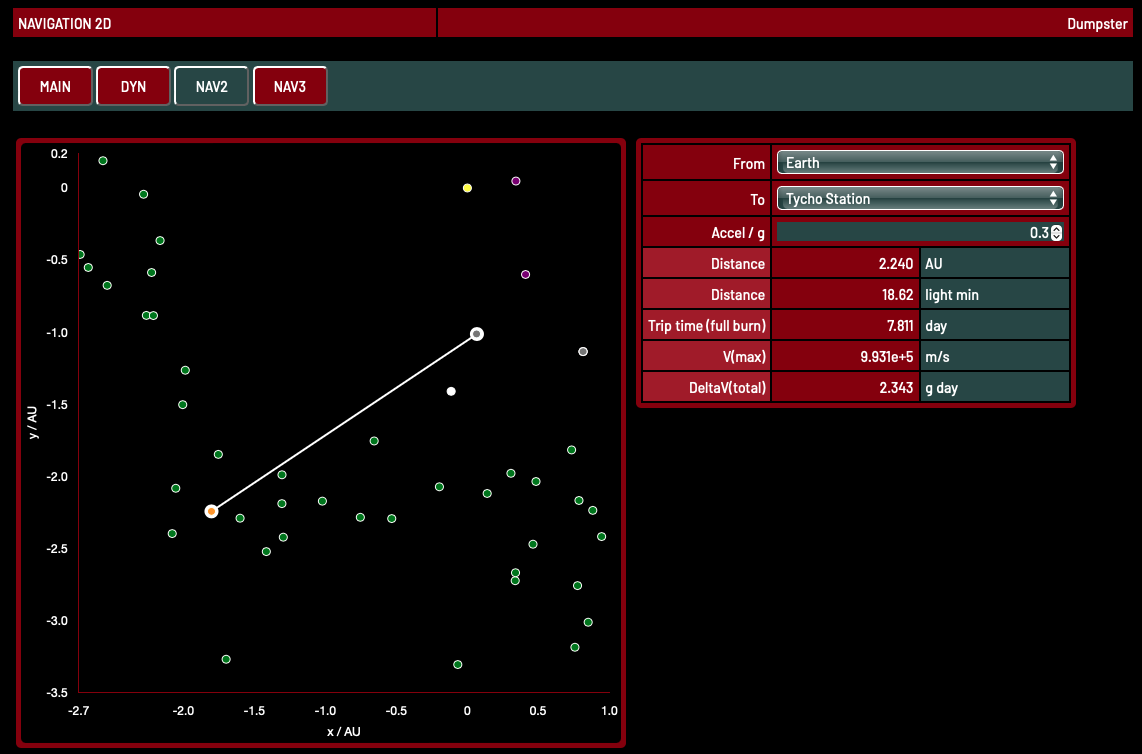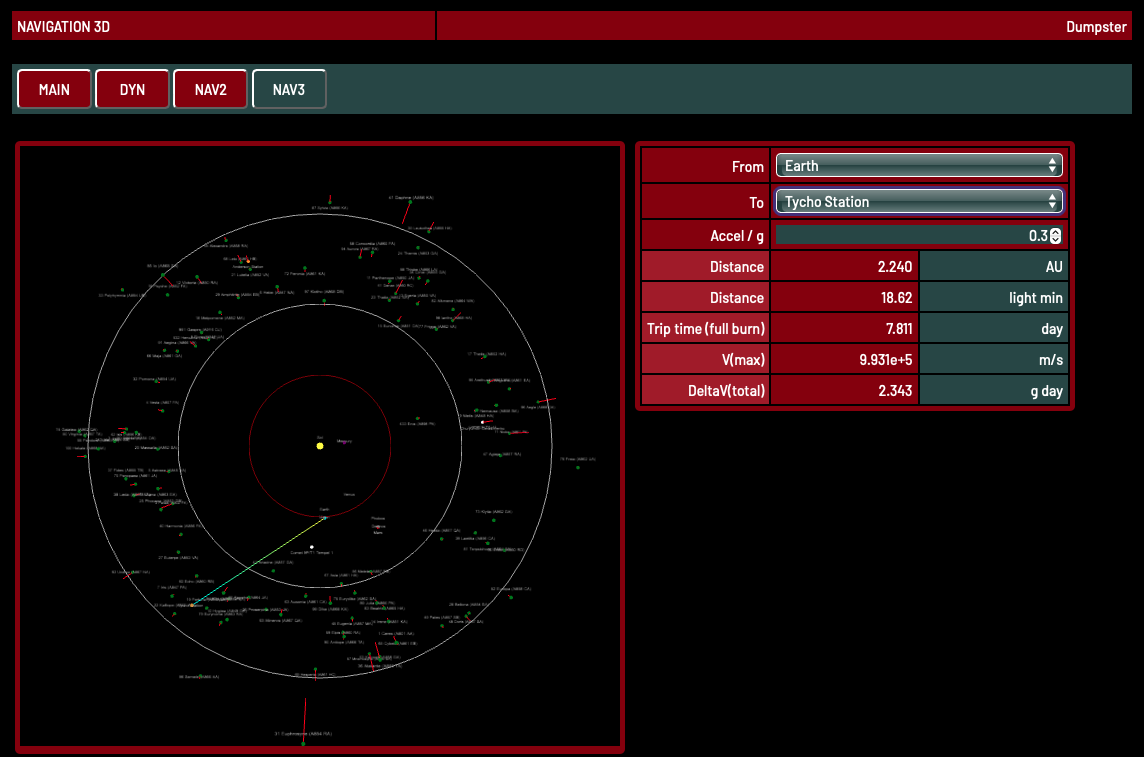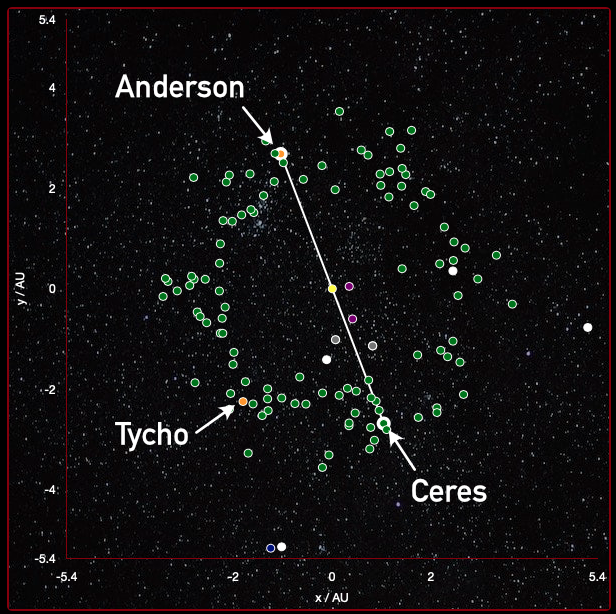
Notes about NAV2 and NAV3 ship displays
This page gives background information about the NAV2 and NAV3 navigation ship displays. They calculate distances between objects on 1 July 2351 (about the start of The Expanse).
Most of the time you will be better off using NAV2T, which enables you to determine positions for other dates.
The two displays are very similar. They only differ in that NAV2 has a 2D plot of the solar system, whilst NAV3's is 3D.
Warning: NAV3 is quite processor intensive. It works fine on a computer but may not work well on a phone or tablet.
Most of the time you will be better off using NAV2T, which enables you to determine positions for other dates.
The two displays are very similar. They only differ in that NAV2 has a 2D plot of the solar system, whilst NAV3's is 3D.
Warning: NAV3 is quite processor intensive. It works fine on a computer but may not work well on a phone or tablet.
Overview of NAV2 and NAV3
Both NAV2 and NAV3 enable you to determine the distances between key places in the solar system. NAV2 displays them as a 2D plot. NAV3 uses a 3D plot, looks nicer, but requires a lot more computing and may not work on phones and tablets.


Locations included
Key places include:
- Sol
- The eight planets
- Three moons: Luna, Phobos, Deimos
- Pluto
- Asteroids 1 to 100 (1 Ceres to 100 Hekate)
- Asteroids 243 Ida, 433 Eros, 532 Herculina, 951 Gaspra
- Comets Tempel 1, Wild2, and Borelly
- 90377 Sedna
- Tycho Station and Anderson Station from The Expanse
Location data
NAV2 and NAV3 use data from the JPL Horizons system to display the Expanse solar system in 1 July 2351.
Use NAV2T if you want positions for other dates.
Use NAV2T if you want positions for other dates.
Date
The locations are for 1 July 2351.
If you want to use distances for other times, use NAV2T.
I can also recommend https://www.wolframalpha.com/input?i=+distance+from+earth+to+mars+1%2F7%2F2351
You will need to know the date that the Expanse is set, and keep track of time. See: https://scifi.stackexchange.com/questions/156761/when-does-the-expanse-take-place
If you want to use distances for other times, use NAV2T.
I can also recommend https://www.wolframalpha.com/input?i=+distance+from+earth+to+mars+1%2F7%2F2351
You will need to know the date that the Expanse is set, and keep track of time. See: https://scifi.stackexchange.com/questions/156761/when-does-the-expanse-take-place
Station locations

I put Anderson Station and Tycho Station on the same orbit as Ceres, with Tycho at a L4/L5 Ceres lagrange point, and Anderson opposite Ceres (at L3).
Comparison with distances in Green Ronin's Expanse RPG
How do the NAV values compare with the rules?
Here are values for some distances from Green Ronin, followed by those from Wolfram Alpha (e.g. https://www.wolframalpha.com/input?i=+distance+from+earth+to+mars+1%2F7%2F2351), and then from NAV2/NAV3. Units are astronomical units. The Wolfram and NAV values are for 1 July 2351.
Earth to Mars: 0.52, 0.760, 0.759
Earth to Jupiter: 4.2, 4.35, 4.35
Earth to Pluto: 38.35, 49.52, 49.66
The Wolfram and NAV numbers are in very good agreement (probably because both use data from the JPL Horizons system.
The Green Ronin values are quite different. Perhaps because they are using averaged values.
Have a look at this article for a good discussion of how to average distances: https://physicstoday.scitation.org/do/10.1063/PT.6.3.20190312a/full/.
The results are, initially, surprising.
Which is, on average, the closest planet to Earth? Mercury!
Which is, on average, the closest planet to Saturn? Mercury!
Here are values for some distances from Green Ronin, followed by those from Wolfram Alpha (e.g. https://www.wolframalpha.com/input?i=+distance+from+earth+to+mars+1%2F7%2F2351), and then from NAV2/NAV3. Units are astronomical units. The Wolfram and NAV values are for 1 July 2351.
Earth to Mars: 0.52, 0.760, 0.759
Earth to Jupiter: 4.2, 4.35, 4.35
Earth to Pluto: 38.35, 49.52, 49.66
The Wolfram and NAV numbers are in very good agreement (probably because both use data from the JPL Horizons system.
The Green Ronin values are quite different. Perhaps because they are using averaged values.
Have a look at this article for a good discussion of how to average distances: https://physicstoday.scitation.org/do/10.1063/PT.6.3.20190312a/full/.
The results are, initially, surprising.
Which is, on average, the closest planet to Earth? Mercury!
Which is, on average, the closest planet to Saturn? Mercury!
